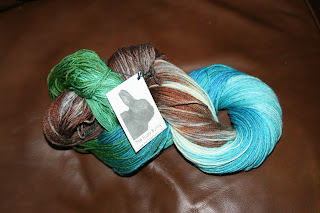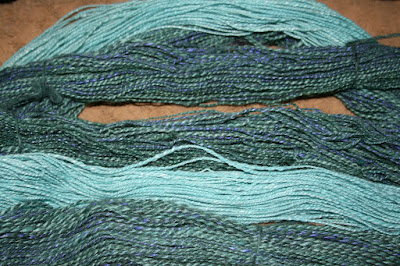Spoiler Alert: It's All My Doctor's Fault
So, last year, I got to thinking that I really really like mushrooms. They taste good with butter. They taste good in recipes. So I started researching growing them myself, thinking that I could eat more mushrooms for less money. This did not turn out to be true, particularly after factoring in the doctor's bill and some concerns he had about mushroom growing, but certainly it seemed like a good idea at the time.
I started by going to a one hour class on growing mushrooms. I bought a jar with reishi mushroom spores that had been soaked onto little wooden dowels. Again, it seemed like
such a good idea. We went home and floundered around looking for logs. Mushrooms are pickier than you might think. You can't just snag a log off the logpile. You need something relatively recently cut, and from a healthy tree. My cousin Susie offered up some logs, so we got out the drill and drilled holes and plugged the dowels into the holes and painted the holes with melted wax. Ongoing maintenance became the next issue. We had to figure out how to keep the logs cool and damp.
To keep the logs happy, I had an unused garbage can, so every two weeks, I filled it with water and let the logs soak overnight. Then I put them back under my porch. This didn't seem like a bad idea for the first few weeks, but eventually it became a bit of a chore. Now I'm looking at those logs and thinking that for this season, I would rather do just about anything other than fill that garbage can with water, drag out the logs, soak them, put them back under the porch, and then, being a waste-not want-not kind of gal, using up the water in the garbage can to water my plants.
By the way... reishi mushrooms don't actually taste good. They are used to make a medicinal tea that supposedly wards off cancer and diabetes and all sorts of other things. But you won't be frying them in butter. As it turns out, I do make reishi tea, not from my personal stock of mushrooms, though, because it's year one and they haven't actually grown. I bought my mushrooms over the internet. I make the tea (after researching "How to make reishi tea that doesn't taste awful") with pomengranite juice and assorted other ingredients in my Instant Pot. And then I make ice cubes, and I pop an ice cube into my water at night. For the record, reishi tea with pomengranite juice and assorted other ingredients pretty much tastes like tree bark. You have to have an adventurous spirit to enjoy it.
With more research, I decided I would try growing mushrooms indoors. You can buy a bag of mushroom spores in sawdust. You slice some lines in the bag, spritz it with water several times a day, and after a bit, you get mushrooms leaping out of the bag. This too seemed like a good idea at the time. But spritzing multiple times per day began to wear on my soul. We got our first flush of mushrooms from one of the bags and ate them all in two days. The second bag did nothing. Eventually I looked more carefully at the second bag and realized that I had purchased a big bag of mushroom spores. Worse, they were not attached to wooden dowels, so actually using them would require additional effort, and perhaps a piece of pricey equipment that would allow me to insert them into drilled holes in logs. Fortunately, I had completely destroyed this batch of mushrooms by cutting slits in the bag and repeatedly watering them, so I did not end up having to purchase the pricey piece of equipment. This batch became compost. Oh, and the first batch? The literature said you could get multiple flushes from the bag, but we had to go on vacation, so a solid week of not spritzing finished off the first bag. More compost.
I was pretty well set to stop trying to grow mushrooms, but my cousin Michelle mentioned wine cap mushrooms. They are supposedly the easiest to grow. I researched that, and concluded that if I had sawdust and woodchips, I could grow them in my two back flower beds. They have peonies in them and the area is very shadey. Just as I was pondering where to get sawdust and woodchips, our neighbors across the street decided to cut down a tree. "Could we have the sawdust?" They said sure. So they had this enormous tree cut down and we put the wagon on our lawn mower and headed over and collected up all the sawdust and took it over to our yard. That probably sounds like a light-hearted effort, doesn't it? Nope. We were sweating. But it wasn't the worst form of exercise we'd ever come up with. So we did that, realized woodchips were next, and asked if we could have those too. The guy who was chipping up the tree said we could have the woodchips, but we'd need to get in and get them the same day, because he had somebody who would come after he finished who would clean up the yard afterward.
Once more, we got the lawn mower and wagon out, along with our trusty shovels. And we started feverishly working to move those woodchips to our backyard. Things were going pretty well until our neighbor suggested that
he had a lawn mower with a wagon too, so maybe my husband could fill his, take it to our yard, and while he was doing that, I could fill the neighbor's wagon. We'd get things done twice as fast! OHMYGOSH, WHAT WAS I THINKING? I'm an old out of shape woman, and filling up those wagons twice as fast nearly killed me. But by golly, we got it all done, everything was bagged up and ready to roll.
Now, this next part is my husband's fault. He should own it. He looked at the flower beds and said, "Well, I'm worried that we're going to put all that sawdust and woodchips down, and it'll blow all over the yard." So that night, I looked on craigslist for a solution, and sure enough, I found it. A fellow a couple towns away had been given an ultimatum. Get rid of the paving stones that had been sitting next to the driveway for 2 years, or find a new wife. So he put up an ad that said "600 paving stones for $50, must be moved by tomorrow." OK, so, first off, I didn't think 600 paving stones would be all that much to move. And I assumed we could move them all in one shot on our trailer that attaches to our van. And the weather conditions were not conducive. Nonetheless, we scored the deal and started texting the guy because he said we couldn't come to get the paving stones until 6pm, and the weather channel was predicting a big wet storm starting at 6pm. "Could we come earlier?" He finally agreed we could come at 4pm, so we did. It was pouring rain, and we started piling paving stones into the trailer. And that's when my husband explained that this was going to take three or four trips, which meant we'd have to fill the trailer, take it home, empty the trailer, and go back.
We begged some more and the paving stones guy's wife said we could take two days instead of just one. So we moved and unloaded two loads in the rain, and the next day we moved the rest. Now, through all this, I was moving a bit faster than my husband. He's 8 years older than me, and this was my dumbass idea, so I figured the least I should do is try to do the bulk of the work. So I was pretty tired after that second day, and having some trouble moving around. But we had the last load in the trailer, in the backyard, just waiting for someone to empty the trailer, and I thought, for my big romantic gesture, that I would empty the trailer myself, on the morning of the third day. So I picked up a couple of bricks and put them in the pile. And then my husband came out on the deck and said, "What are you doing?" and I picked up two more bricks, and that's when my back went out. So, apparently, not moving bricks, thank you very much.
So the day wore on, and I was in lots of pain and we dug out the heating pad and the Tylenol, and nothing much was helping. So we got onto the internet and read up on what to do for back pain, and I swear, WebMD said that walking would be the best thing for it, to loosen things up. So every day I got up and we went for a walk. A hideous, painful, "Ohmygosh, why did I buy those paving stones?" walk. Eventually I had to concede defeat, so we went to see my doctor.
"What did you do?" We told him the story. "And then what did you do?" We told him what WebMD said, and he rolled his eyes. I'm pretty sure he put his head in his hands. "Did it help?" "Um. No." "What else did you do?" "Well, we went to a wedding, but I swear we didn't do any dancing at the reception." "And why were you moving paving stones?" We explained about the mushrooms. And that's when we got a hearty lecture about people who don't know anything about mushrooms growing mushrooms. Pretty much, the message was, if the spores you bought like your setup, what's to keep other types of mushrooms from growing? And, you could die. So, he prescribed muscle relaxants and the heating pad and not walking until I didn't think I was going to die from walking.
In spite of the sage advice, we had gone to a lot of effort to gather our supplies, so we decided to plant the mushrooms. With my back recovered, I carefully laid down the sawdust, then put down the mushroom spores, then added the woodchips, and then circled the flower beds with paving stones. It really looked quite nice.
The mushrooms have started coming up. And we're looking at them, and I'm like, "Err... some of them are maroon on top, and some are not." And my husband says, "Well, we should at least take pictures and see if anyone can tell us which are which." And I said, "Well, first, I don't want to take a chance on dying from mushroom poisoning. It would be an embarrassing thing to have to put in my obituary. And second, I wouldn't want to be you if I
did die of mushroom poisoning, because you'd have to explain it to the doctor. Let's just leave 'em here and let the deer and the bugs eat them."
And so it is, I will not be a mushroom farmer after all.
 |
| There's a pretty good chance that this is a winecap mushroom. It is maroon-colored. |
 |
These, on the other hand, are not maroon-colored. They look brown.
Sigh. |
The end.

















































